This is a case study of a patient who had a bad experience from a clinic operating in Malaysia. Without doing proper research, the unsuspecting patient, a Malaysian-Chinese man, aged 27, fell victim to a bad hair transplant. The patient was looking for a hair restoration surgery due to his receding hairline and was promised a successful result. Unfortunately, the doctor had little experience and harvested his hair from a non-safe donor area (Figure 1).
An experienced hair restoration surgeon would know where the appropriate donor area or the safe zone is, and why it’s important to harvest only from that zone. Unlike the donor site, hair at the non-safe donor area of patients suffering from male pattern baldness are genetically coded to fall off and have no resistance to baldness, and therefore are not permanent.

Case study submitted by: Inderjit Kaur, MBBS, ISHRS Member, Diplomate of ABHRS
CEO of Klinik Dr Inder, Kuala Lumpur, Malaysia.

Choosing the wrong donor site is not the only issue in this case. Another issue is the density discrepancy effect (Figure 2). The density discrepancy can be seen between his native hairline and the restoration zone where there is a huge contrast in the density of the hair. One can see straight through the restored hair to the native zone as there’s zero blending effect. This cosmetic issue is even more evident from the frontal and side views. This is due to the poor hair growth where hair harvested from the non-safe zone fell off after some time, despite the initial high-density restoration. This causes the hair density to decrease thus creating the density discrepancy effect.
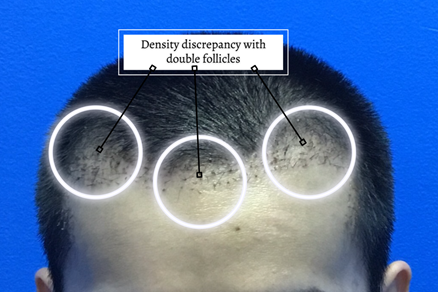
In addition, the hairs are also placed angularly incorrect and inconsistent. The improper angulation of the grafts is due to the recipient site not properly angled, causing the hair to be placed perpendicular to the scalp and not following the region’s ideal angle of growth (Figure 3)
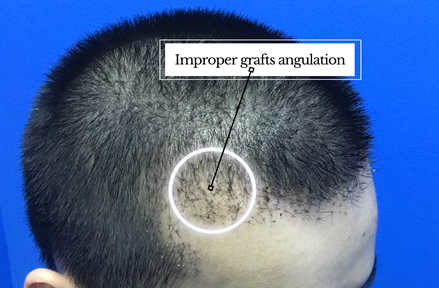
Another thing to address is the construction of the temporal points on a young patient. (Figure 4). An individual as young as this patient with significant hair loss would be the worst candidate to get temporal points. The reason is that someone young with a hair loss may run out of donor hair to cover the temporal loss that can potentially develop in other parts of the head that would later suffer from hair loss. The error of judgement on the right candidate in this case may be due to unethical business practice or lack of knowledge on the part of the doctor, which is highly unacceptable.

The patient informed Dr. Inder Kaur that he went back to the clinic to complain about the result but was told by the doctor there that it looked good and that it was normal. The unhappy patient who disagreed with the doctor’s conflicting opinion was offered a fix for free. However, according to him, and rightfully so, he preferred to not have this doctor touch his head again.
As a customer who is serious about results, he learned the hard way and was determined to find a qualified and licensed practice through extensive research. That’s when he found Dr. Inder Kaur’s clinic and decided to have a corrective treatment and get a proper hair restoration. When he went to see Dr. Inder Kaur, he was advised to wait for the hair to grow longer and come back. This was to enable a better assessment of his condition. He did as advised and returned for a hair restoration surgery (Figure 5).
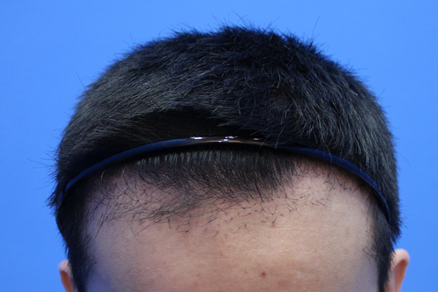
During consultation, Dr. Inder Kaur noticed the improper result. The patient showed pictures after the first hair restoration. The grafts decreased in density which may be due to several factors including:
● Hair harvested from a non-safe donor area are not permanent
● Poor growth
● Improper instruments used
● Low-quality or incorrect holding solutions
● Restoration was not properly done
● Hair grafts were not stored properly
● Inexperienced doctor or lack of knowledge in hair restoration surgery
Dr. Inder Kaur constructed a new hairline covering the same restoration area for a new restoration (Figure 6).
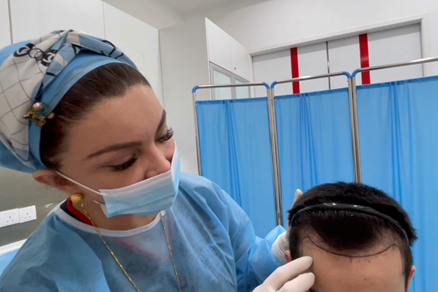
The patient’s head was fully shaved off and the donor site is marked (Figure 7).
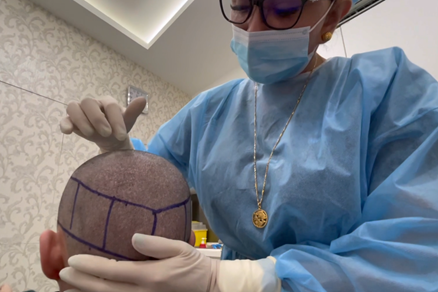
Dr. Inder Kaur performed a corrective restoration by extracting the double follicles from the recipient’s zone (Figure 8).

1500 grafts were harvested from the donor site or the safe zone before restored on the new hairline (Figure 9).
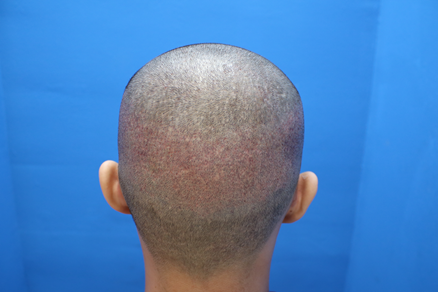
Newly harvested grafts fill up the previous restoration area, increasing the density while delivering a proper blending effect with the native hairline (Figure 10).
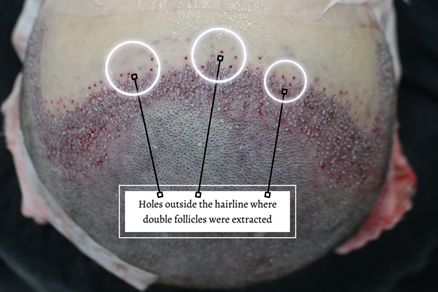
Patients need to do thorough research on which practice has legitimate qualifications to perform a surgery. There are many clinics out there which are operating without the proper expertise to run the clinic. Practitioners are obligated to educate and create awareness among the public on the ethical business practice so potential customers will know how to make the right decision.
The basic knowledge of male pattern baldness hair loss should be clearly understood before proceeding with a hair restoration surgery:
● Knowing where the safe permanent donor area is
● Knowing that male pattern baldness is progressive
● Evaluate the age of the patient; a more conservative approach needs to be taken when it comes to young patients’ hair loss
● Assessment of donor supply is important to meet patients expectations with what can be accomplished with hair restoration.
● Patient’s family history provides guidelines on the patient’s progressive hair loss.
● It’s not about the number of grafts harvested; it’s the ones left for the next hair restoration if progressive hair loss gets aggressive.